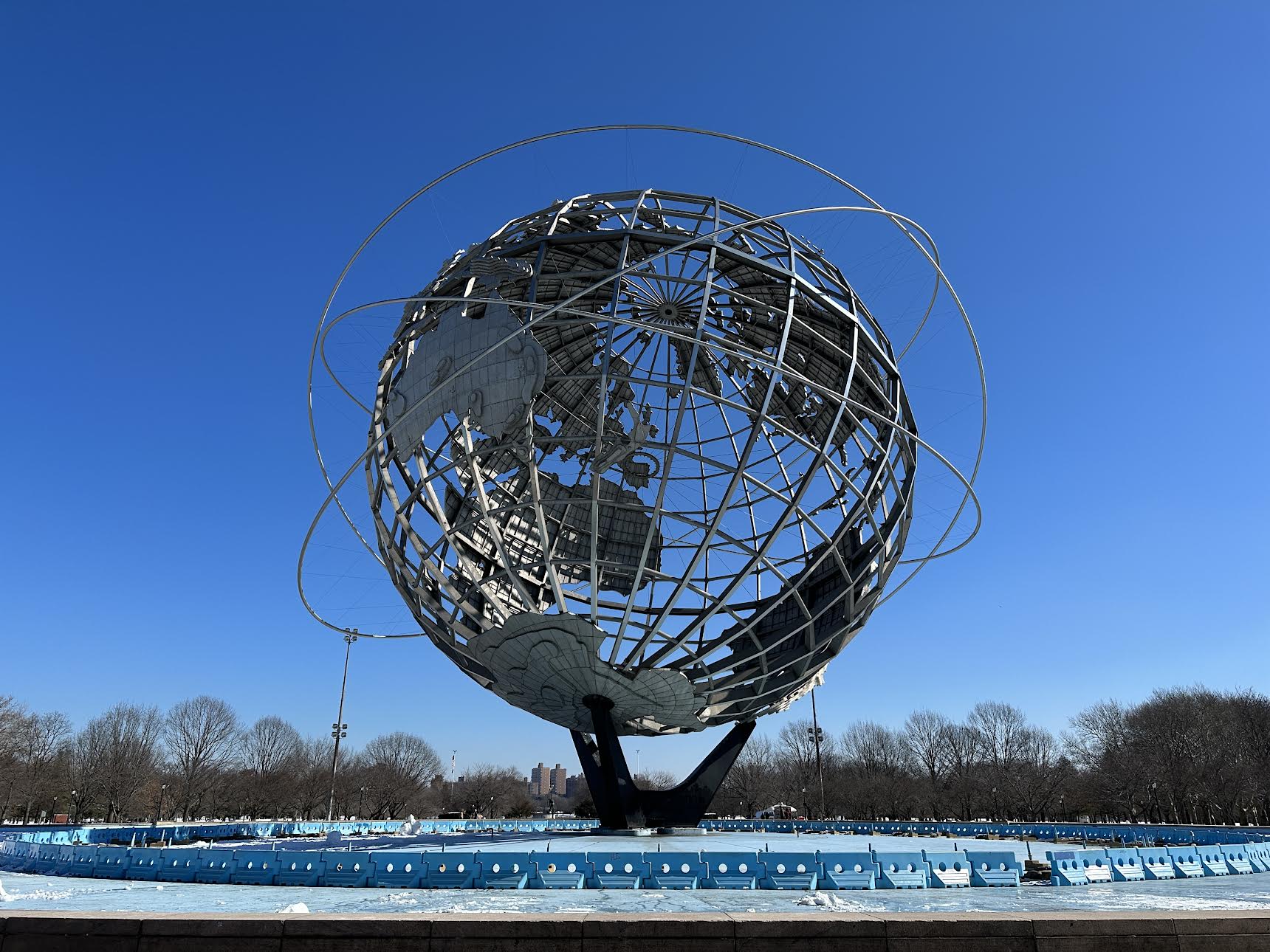
The Unisphere is shown during the tour of the park grounds. (Credit: Alan Kronenberg)
With their backs to Australia, a shivering group of visitors faced urban park rangers Jeff Roche and Eric Bochnak. The eight strangers shifted in place to keep warm, waiting for the rangers to kick things off.
Ranger Bochnak, wearing gloves, looked at a clipboard, while Roche, gloveless, held a green tote. In the reflection of Roche’s sunglasses was perhaps the most well-known feature of this tour: the Unisphere, which is “the largest manmade representation of the globe,” Roche later said.
After introducing themselves and their roles, the two urban park rangers assigned to the borough of Queens delighted the visitors with a fact: “We’ve got a pair of nesting red-tailed hawks in the Unisphere,” said Bochnak, 30. “They’ve been there for the past few seasons.”
“They have a nest up in Kenya,” added Roche, 25. “But you can’t see it from this side of the globe.”
Then, gesturing toward the massive steel sphere, Roche said, “So as we’re standing in front of the Unisphere, it’s a good place to start off the tour.”
The February tour was of the 1964-1965 World’s Fair grounds in Flushing Meadows Corona Park in Queens. The free event commemorates this year being the 60th anniversary of the fair and was hosted by the urban park rangers, who are a part of the New York City Department of Parks and Recreation.
The Unisphere stands 12 stories tall and weighs 700,000 pounds with three orbiting rings encircling it. The globe “represents man’s progress in an ever-expanding universe,” Roche said.
But the park itself, he noted, was created for the 1939 World’s Fair, built on the ash dump familiar from F. Scott Fitzgerald’s “The Great Gatsby” to represent the fair’s theme, the “World of Tomorrow.”
Walking eastward toward South America, the group saw one of the red-tailed hawks land on top of the Unisphere, pushing off snow from the previous day’s snowfall.
“Why is it up there?” asked an elderly man.
“Well, they actually have three nests in the globe,” said Roche, who studied natural resources and environmental sciences at the University of Illinois at Urbana-Champaign. “And one of them is up there in the Arctic.”
Circling around to West Africa, the tour continued. A couple of hundred yards away, the group headed down a path toward a shabby wooden fence surrounding an approximately 9-foot, whitish-red column topped with a clear plastic bag.
“This is the Column of Jerash,” said Roche. “And as you can see it’s been vandalized quite a bit, since it used to stand 18 feet tall.”
The column was bestowed to Robert Moses, the fair’s head organizer, by King Hussein of Jordan, said Bochnak, a Queens native.
“When I was a teenager, I used to come to the park, but I never noticed the column,” Bochnak added.
“Yeah,” said Roche, “there’s a lot of artifacts around the park that most people forget about.”
Stopping at the 1963 “Rocket Thrower” sculpture, Bochnak noted that about half of the park was used for the fair. He gestured past the 43-foot-tall bronze statue toward a large, crescent-shaped body of water in the distance.
This was called the Pool of Industry during the fair, and it used to have central fountains called the Fountain of the Planets, according to schematics the rangers previously showed of the fair’s layout.
On what are now soccer fields, Peggy Dorfman, 71, from Willoughby, Ohio, recalled visiting the buildings of industry that used to surround the aptly named pool. She was 11 then, and she remembered a pavilion sponsored by the Parker Pen company where “you could go there and sign up to have a pen pal from somewhere in the world.”
After filling out some forms that were put into a computer, she said, she was matched with a girl around her age named Birgitta from Lycksele, Sweden. “I must have written my initial letter there,” Dorfman said. “Then I think a few weeks later, I heard from Birgitta.”
The two corresponded, Dorfman said, for a couple of years. But they lost touch after that and have never reconnected, making this another memory of what once was from the 1964 World’s Fair.
Heading back toward the Unisphere, the rangers pointed out detailed depictions of the 1939 and 1964 World’s Fairs etched into the black granite walkway.
“You can really see the differences between the fairs in these,” Roche said.
The 1939 section showed futuristic depictions of things like travel and industry, whereas the 1964 section illustrated international unity, befitting the fair’s theme of “Peace through understanding.”
Approaching the Unisphere, other park visitors took photos in front of the iconic landmark, as a bit of snow flaked off of the Himalayas and disintegrated before reaching the ground.
About the author(s)
Alan Kronenberg, from Cleveland, Ohio, is a Master of Science student at the Columbia Journalism School.



